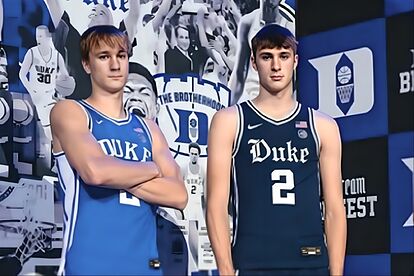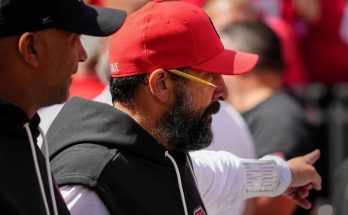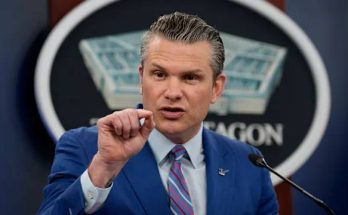Cooper Flagg has been a household name in the world of high school basketball for quite some time, drawing attention from fans, recruiters, and analysts alike. With his exceptional skill set, size, and basketball IQ, Cooper has carved out a reputation as one of the most promising young talents in the country. His name often headlines highlight reels, scouting reports, and social media conversations, creating an aura of excitement around his future in the sport. Yet, amid all the attention that Cooper Flagg garners, there is another story quietly unfolding that has the potential to reshape the way people think about this dynamic duo. That story belongs to his twin brother, whose abilities on the court may not yet command the same spotlight but are increasingly difficult to ignore. While Cooper has been celebrated as a prodigy, his twin’s trajectory suggests that the true sleeper of the family could very well be the one flying under the radar.
The narrative around athletic families often gravitates toward the individual who bursts onto the scene first. In the case of the Flagg family, Cooper’s early emergence created an immediate benchmark against which his twin brother was inevitably measured. From a young age, Cooper displayed an uncanny combination of size, agility, and basketball instincts that allowed him to dominate games, drawing attention from scouts across the nation. As a result, media outlets, college recruiters, and fans naturally gravitated toward him, elevating his profile to that of a star. However, the twin’s story is not simply one of living in someone else’s shadow. Instead, it is a tale of untapped potential, meticulous development, and a style of play that may ultimately complement and even surpass expectations established by his brother’s early success.
The first point of interest when evaluating Cooper Flagg’s twin is the concept of skill refinement versus raw talent. While Cooper has always impressed with his natural gifts, his twin has focused on refining particular aspects of his game that often go unnoticed but can dramatically influence performance at higher levels. For example, aspects like defensive positioning, off-ball movement, and shooting mechanics are areas where subtle improvements can translate into substantial gains on the court. Observers who have had the opportunity to watch the twin in live settings or on limited highlight footage often remark on his attention to detail, poise under pressure, and adaptability to different defensive schemes. These qualities, while not as flashy as highlight dunks or ankle-breaking crossovers, are critical in building a player who can sustain success at the collegiate and professional levels.
Another element that makes Cooper Flagg’s twin a compelling sleeper prospect is his versatility. Modern basketball increasingly demands players who can contribute in multiple roles, both offensively and defensively. The twin has demonstrated the ability to fill various positions, handle the ball under pressure, and make intelligent decisions in transition. This versatility provides coaches with the flexibility to experiment with lineups and strategies, making him an asset in ways that may not be immediately obvious when comparing him to a more celebrated sibling. In some cases, having a skill set that complements a star player rather than competing with it directly can be an advantage, allowing the twin to grow in his own right while still benefiting from the shared knowledge and practice environment of a talented family member.
Physical development is another factor that often plays a role in sleeper potential. In basketball, timing, growth spurts, and muscle development can dramatically alter a player’s trajectory between ages fifteen and eighteen. While Cooper may have reached his physical peak earlier, his twin has been steadily catching up, sometimes in ways that are subtle but impactful. Increased strength, improved endurance, and refined footwork all contribute to a player’s overall effectiveness on the court. For scouts and analysts, recognizing these changes before they fully manifest in highlight-reel moments can be a key indicator of long-term potential. The twin’s physical progression suggests that the next few years could see him emerge as a player whose impact is both measurable and significant, particularly in high-stakes games where consistency and composure are paramount.
Psychological factors also play a crucial role in the sleeper narrative. Growing up alongside a sibling who garners national attention can be both motivating and challenging. On one hand, it can create pressure to live up to external expectations; on the other, it provides a built-in mentor and competitive environment that fosters resilience. Cooper Flagg’s twin appears to be leveraging this environment to cultivate mental toughness, focus, and strategic thinking. Interviews with coaches and teammates often highlight his quiet confidence, work ethic, and willingness to embrace constructive criticism—traits that are invaluable in the high-pressure landscape of competitive basketball. Unlike the more publicized journey of his brother, the twin’s development emphasizes the internal growth that often goes unnoticed but is essential for success at the next level.
It is also worth examining the broader implications of this twin dynamic within basketball scouting and recruitment. Often, scouts and analysts are drawn to players with visible accolades, media coverage, and early success, which can inadvertently overshadow those whose potential is more incremental and nuanced. In this context, Cooper’s twin represents a case study in evaluating talent beyond the obvious. Observers who look past highlight reels to consider fundamentals, basketball IQ, adaptability, and growth trajectory are likely to find a player whose value may not be immediately apparent but whose ceiling could be equally high, if not higher, than that of a sibling with more media attention. This perspective challenges traditional scouting narratives and emphasizes the importance of comprehensive evaluation over hype-driven assessments.
Another compelling aspect of Cooper Flagg’s twin is the potential for a complementary playing relationship. The synergy between talented siblings has been demonstrated repeatedly in basketball history, with examples ranging from the Morris twins to the Gasol brothers. When two players understand each other’s tendencies, strengths, and weaknesses inherently, it can create an on-court chemistry that elevates both individuals. The twin’s understanding of Cooper’s style, combined with his own skill set, allows for creative offensive schemes, fluid defensive rotations, and a level of communication that is difficult to replicate. This dynamic not only enhances their individual prospects but also contributes to team success, whether at the high school, AAU, or collegiate level.
It is natural to ask why Cooper’s twin has not yet received the same level of attention. The answer lies partly in exposure, narrative framing, and the timing of individual accomplishments. Media and social platforms often highlight spectacular performances, buzzer-beaters, or unique physical attributes, which tend to favor those who break out early. Meanwhile, players whose contributions are steady, consistent, and strategically impactful may accumulate recognition more slowly. This does not diminish their potential; in fact, it often allows for growth without the weight of public expectation, giving them space to refine their game and surprise audiences at a later stage. In this sense, the sleeper designation is as much about timing and perception as it is about inherent ability.
Looking ahead, the path for Cooper Flagg’s twin involves continued refinement, strategic exposure, and performance in high-stakes settings. Showcasing his abilities in competitive tournaments, all-star games, and selective recruiting events can help bridge the recognition gap while providing tangible proof of his impact. Moreover, leveraging the mentorship and shared experience with Cooper can accelerate development, providing insight into handling pressure, navigating recruitment, and maintaining focus amidst public attention. For coaches, scouts, and fans, the twin represents an intriguing blend of talent, potential, and understated effectiveness—an opportunity to witness a player whose rise may unfold in a less predictable but ultimately rewarding manner.
The broader lesson in following Cooper Flagg and his twin is the importance of looking beyond the obvious star. In sports, narratives are often shaped by who catches the eye first, who dominates headlines, and who inspires social media buzz. Yet, the true story is frequently more complex, involving players whose growth is gradual, whose impact is subtle, and whose ceiling may rival or surpass the initial standout. Observing Cooper’s twin with attention to detail, context, and trajectory offers a richer understanding of athletic development and highlights the value of comprehensive evaluation in predicting future success. In this sense, the twin is not merely an ancillary figure in Cooper’s narrative; he is an independent talent whose story is just beginning to unfold.
As fans, analysts, and recruiters engage with this unfolding story, it is exciting to consider the possibilities. The twin’s trajectory is a reminder that talent often exists in layers, and that the sleeper—quiet, methodical, and consistently improving—can redefine expectations. For those who have followed Cooper Flagg’s rise, there is a unique opportunity to witness another chapter of excellence emerging from the same family, one that challenges assumptions, rewards patience, and demonstrates the multifaceted nature of basketball talent. Encouragingly, the conversation around the Flagg twins is not limited to recruiters or insiders; fans have a role to play as well, sharing observations, predictions, and insights as both brothers continue to develop. Comment sections, forums, and social media provide the perfect platform for dialogue, speculation, and celebration of emerging talent, fostering a community that appreciates the nuances of player development and the thrill of uncovering a true sleeper.
Ultimately, the story of Cooper Flagg and his twin is a compelling illustration of how talent, opportunity, and perception intersect in sports. While Cooper has earned his fame and accolades through natural ability and early achievement, his twin embodies the sleeper archetype—an individual whose potential may be fully realized in the coming years, whose skills complement and enhance those of a celebrated sibling, and whose journey offers valuable lessons in patience, observation, and recognition of subtle excellence. For fans of basketball, this is more than a family story; it is an invitation to look deeper, engage thoughtfully, and appreciate the complexities of athletic development. The twin’s rise promises to be a narrative worth following, a testament to the idea that sometimes the most remarkable stories unfold quietly before they captivate the world.
If you’ve been following the Flagg family or have insights into Cooper’s twin, share your thoughts in the comments. Do you think the twin has the potential to surpass Cooper, or will his success take a different form? Your perspectives and observations can add depth to this unfolding story and create a vibrant discussion around one of basketball’s most intriguing sibling narratives.



